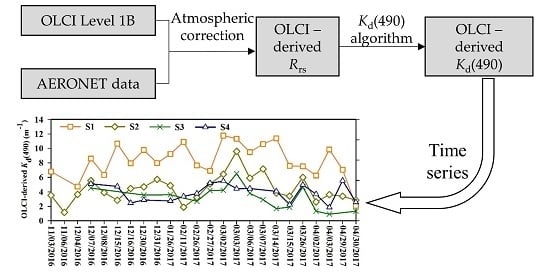Determination of the Downwelling Diffuse Attenuation Coefficient of Lake Water with the Sentinel-3A OLCI
Abstract
:1. Introduction
2. Materials and Methods
2.1. Study Area
2.2. Field Measurements
2.3. Satellite Image Acquisition and Pre-Processing
2.4. Meteorological Data
2.5. Statistical Analysis and Accuracy Assessment
3. Results
3.1. Biogeochemical and Optical Characterization
3.2. Atmospheric Correction Assessment
3.3. Development and Validation of the Kd(490) Algorithm
3.4. Temporal and Spatial Patterns from the OLCI-Derived Kd(490) in Lake Taihu
4. Discussion
4.1. Performance of the OLCI Kd(490) Algorithm
4.1.1. Challenges in Estimating Kd(490) Using Satellite Data
4.1.2. Comparison with Existing Algorithms Using the OLCI-Derived Rrs
4.1.3. Applicability of the Algorithm to Other Lakes
4.2. Comparison between the OLCI-Derived and MODIS-Derived Kd(490)
4.3. Mechanisms of the Spatio-Temporal Variations in the Kd(490) Distribution
5. Conclusions
Acknowledgments
Author Contributions
Conflicts of Interest
References
- Gordon, H.R. Dependence of the diffuse reflectance of natural waters on the sun angle. Limnol. Oceanogr. 1989, 34, 1484–1489. [Google Scholar] [CrossRef]
- Gordon, H.R.; Brown, O.B.; Jacobs, M.M. Computed relationships between the inherent and apparent optical properties of a flat homogeneous ocean. Appl. Opt. 1975, 14, 417–427. [Google Scholar] [CrossRef] [PubMed]
- Baker, K.; Smith, R. Quasi-Inherent Characteristics of the Diffuse Attenuation Coefficient for Irradiance. Proc. SPIE 1980. [Google Scholar] [CrossRef]
- Lee, Z.P.; Du, K.P.; Arnone, R. A model for the diffuse attenuation coefficient of downwelling irradiance. J. Geophys. Res. Oceans 2005, 110. [Google Scholar] [CrossRef]
- Mobley, C.D. Light and Water: Radiative Transfer in Natural Waters; Academic Press: Cambridge, MA, USA, 1994. [Google Scholar]
- Kirk, J. Monte carlo study of the nature of the underwater light field in, and the relationships between optical properties of, turbid yellow waters. Mar. Freshw. Res. 1981, 32, 517–532. [Google Scholar] [CrossRef]
- Majozi, N.P.; Salama, M.S.; Bernard, S.; Harper, D.M.; Habte, M.G. Remote sensing of euphotic depth in shallow tropical inland waters of Lake Naivasha using meris data. Remote Sens. Environ. 2014, 148, 178–189. [Google Scholar] [CrossRef]
- Ma, R.; Tang, J.; Dai, J.; Zhang, Y.; Song, Q. Absorption and scattering properties of water body in Taihu lake, China: Absorption. Int. J. Remote Sens. 2006, 27, 4277–4304. [Google Scholar] [CrossRef]
- Stramska, M.; Zuzewicz, A. Influence of the parametrization of water optical properties on the modelled sea surface temperature in the Baltic sea. Oceanologia 2013, 55, 53–76. [Google Scholar] [CrossRef]
- Wu, Y.; Tang, C.C.; Sathyendranath, S.; Platt, T. The impact of bio-optical heating on the properties of the upper ocean: A sensitivity study using a 3-d circulation model for the Labrador sea. Deep Sea Res. Part II Top. Stud. Oceanogr. 2007, 54, 2630–2642. [Google Scholar] [CrossRef]
- Loiselle, S.A.; Bracchini, L.; Cózar, A.; Dattilo, A.M.; Tognazzi, A.; Rossi, C. Variability in photobleaching yields and their related impacts on optical conditions in subtropical lakes. J. Photochem. Photobiol. B Biol. 2009, 95, 129–137. [Google Scholar] [CrossRef] [PubMed]
- Mcclain, C.R.; Arrigo, K.; Tai, K.S.; Turk, D. Observations and simulations of physical and biological processes at ocean weather station P, 1951–1980. J. Geophys. Res. 1996, 101, 3697–3713. [Google Scholar] [CrossRef]
- Bergamino, N.; Horion, S.; Stenuite, S.; Cornet, Y.; Loiselle, S.; Plisnier, P.D.; Descy, J.P. Spatio-temporal dynamics of phytoplankton and primary production in Lake Tanganyika using a MODIS based bio-optical time series. Remote Sens. Environ. 2010, 114, 772–780. [Google Scholar] [CrossRef]
- Lee, Z.; Lance, V.P.; Shang, S.; Vaillancourt, R.; Freeman, S.; Lubac, B.; Hargreaves, B.R.; Castillo, C.D.; Miller, R.; Twardowski, M. An assessment of optical properties and primary production derived from remote sensing in the southern ocean (so gasex). J. Geophys. Res. 2011, 116, 111–121. [Google Scholar] [CrossRef]
- Austin, R.W.; Petzold, T.J. The Determination of the Diffuse Attenuation Coefficient of Sea Water Using the Coastal Zone Color Scanner; Springer: New York, NY, USA, 1981; pp. 239–256. [Google Scholar]
- Morel, A.; Huot, Y.; Gentili, B.; Werdell, P.J.; Hooker, S.B.; Franz, B.A. Examining the consistency of products derived from various ocean color sensors in open ocean (case 1) waters in the perspective of a multi-sensor approach. Remote Sens. Environ. 2007, 111, 69–88. [Google Scholar] [CrossRef]
- Lee, Z.; Hu, C.; Shang, S.; Du, K.; Lewis, M.; Arnone, R.; Brewin, R. Penetration of uv-visible solar radiation in the global oceans: Insights from ocean color remote sensing. J. Geophys. Res. Oceans 2013, 118, 4241–4255. [Google Scholar] [CrossRef]
- Lee, Z.P.; Darecki, M.; Carder, K.L.; Davis, C.O.; Stramski, D.; Rhea, W.J. Diffuse attenuation coefficient of downwelling irradiance: An evaluation of remote sensing methods. J. Geophys. Res. Oceans 2005, 110, 93–106. [Google Scholar] [CrossRef]
- Doron, M.; Babin, M.; Mangin, A.; Hembise, O. Estimation of light penetration, and horizontal and vertical visibility in oceanic and coastal waters from surface reflectance. J. Geophys. Res. Oceans 2007, 112, 137–154. [Google Scholar] [CrossRef]
- Wang, M.; Son, S.; Harding, L.W. Retrieval of diffuse attenuation coefficient in the chesapeake bay and turbid ocean regions for satellite ocean color applications. J. Geophys. Res. Oceans 2009, 114. [Google Scholar] [CrossRef]
- Mueller, J.L. SeaWIFS algorithm for the diffuse attenuation coefficient, k(490), using water-leaving radiances at 490 and 555 nm. In SeaWiFS postlaunch Calibration and Validation Analyses; BiblioGov: Columbus, OH, USA, 2000; Volume 3, pp. 24–27. [Google Scholar]
- Kratzer, S.; Brockmann, C.; Moore, G. Using meris full resolution data to monitor coastal waters—A case study from himmerfjärden, a fjord-like bay in the northwestern Baltic Sea. Remote Sens. Environ. 2008, 112, 2284–2300. [Google Scholar] [CrossRef]
- Zhang, Y.; Liu, X.; Yin, Y.; Wang, M.; Qin, B. A simple optical model to estimate diffuse attenuation coefficient of photosynthetically active radiation in an extremely turbid lake from surface reflectance. Opt. Express 2012, 20, 20482–20493. [Google Scholar] [CrossRef] [PubMed]
- Qiu, Z.; Wu, T.; Su, Y. Retrieval of diffuse attenuation coefficient in the china seas from surface reflectance. Opt. Express 2013, 21, 15287–15297. [Google Scholar] [CrossRef] [PubMed]
- Song, K.; Ma, J.; Wen, Z.; Fang, C.; Shang, Y.; Zhao, Y.; Wang, M.; Du, J. Remote estimation of Kd (PAR) using MODIS and Landsat imagery for turbid inland waters in Northeast China. ISPRS J. Photogramm. Remote Sens. 2017, 123, 159–172. [Google Scholar] [CrossRef]
- Chen, J.; Cui, T.; Ishizaka, J.; Lin, C. A neural network model for remote sensing of diffuse attenuation coefficient in global oceanic and coastal waters: Exemplifying the applicability of the model to the coastal regions in Eastern China seas. Remote Sens. Environ. 2014, 148, 168–177. [Google Scholar] [CrossRef]
- Shi, K.; Zhang, Y.; Liu, X.; Wang, M.; Qin, B. Remote sensing of diffuse attenuation coefficient of photosynthetically active radiation in Lake Taihu using meris data. Remote Sens. Environ. 2014, 140, 365–377. [Google Scholar] [CrossRef]
- Zheng, Z.; Ren, J.; Li, Y.; Huang, C.; Liu, G.; Du, C.; Lyu, H. Remote sensing of diffuse attenuation coefficient patterns from landsat 8 oli imagery of turbid inland waters: A case study of dongting lake. Sci. Total Environ. 2016, 573, 39–54. [Google Scholar] [CrossRef] [PubMed]
- Nieke, J.; Borde, F.; Mavrocordatos, C.; Berruti, B.; Delclaud, Y.; Riti, J.B.; Garnier, T. The ocean and land colour imager (olci) for the sentinel 3 gmes mission: Status and first test results. Proc. SPIE 2012. [Google Scholar] [CrossRef]
- Ma, R.; Jiang, G.; Duan, H.; Bracchini, L.; Loiselle, S. Effective upwelling irradiance depths in turbid waters: A spectral analysis of origins and fate. Opt. Express 2011, 19, 7127–7138. [Google Scholar] [CrossRef] [PubMed]
- Duan, H.; Ma, R.; Zhang, Y.; Loiselle, S.A.; Xu, J.; Zhao, C.; Zhou, L.; Shang, L. A new three-band algorithm for estimating chlorophyll concentrations in turbid inland lakes. Environ. Res. Lett. 2010, 5, 044009. [Google Scholar] [CrossRef]
- Luo, J.; Duan, H.; Ma, R.; Jin, X.; Li, F.; Hu, W.; Shi, K.; Huang, W. Mapping species of submerged aquatic vegetation with multi-seasonal satellite images and considering life history information. Int. J. Appl. Earth Obs. 2017, 57, 154–165. [Google Scholar] [CrossRef]
- Ma, R.H.; Duan, H.T.; Gu, X.H.; Zhang, S.X. Detecting aquatic vegetation changes in Taihu lake, China using multi-temporal satellite imagery. Sensors (Basel) 2008, 8, 3988–4005. [Google Scholar] [CrossRef] [PubMed]
- Hu, C.; Lee, Z.; Ma, R.; Yu, K.; Li, D.; Shang, S. Moderate resolution imaging spectroradiometer (MODIS) observations of cyanobacteria blooms in Taihu lake, China. J. Geophys. Res. 2010, 115. [Google Scholar] [CrossRef]
- Duan, H.; Ma, R.; Xu, X.; Kong, F.; Zhang, S.; Kong, W.; Hao, J.; Shang, L. Two-decade reconstruction of algal blooms in China’s Lake Taihu. Environ. Sci. Technol. 2009, 43, 3522–3528. [Google Scholar] [CrossRef] [PubMed]
- Duan, H.; Feng, L.; Ma, R.; Zhang, Y.; Loiselle, S.A. Variability of particulate organic carbon in inland waters observed from MODIS aqua imagery. Environ. Res. Lett. 2014, 9, 084011. [Google Scholar] [CrossRef]
- Cao, Z.; Duan, H.; Feng, L.; Ma, R.; Xue, K. Climate-and human-induced changes in suspended particulate matter over Lake Hongze on short and long timescales. Remote Sens. Environ. 2017, 192, 98–113. [Google Scholar] [CrossRef]
- Cao, Z.; Duan, H.; Shen, M.; Ma, R.; Xue, K.; Liu, D.; Xiao, Q. Using viirs/npp and MODIS/aqua data to provide a continuous record of suspended particulate matter in a highly turbid inland lake. Int. J. Appl. Earth Obs. 2018, 64, 256–265. [Google Scholar] [CrossRef]
- Mitchell, A.B.G. Algorithms for determining the absorption coefficient for aquatic particulates using the quantitative filter technique. Proc. SPIE 1990. [Google Scholar] [CrossRef]
- Yentsch, C.S. Measurement of visible light absorption by particulate matter in the ocean. Limnol. Oceanogr. 1962, 7, 207–217. [Google Scholar] [CrossRef]
- Bricaud, A.; Morel, A.; Prieur, L. Absorption by dissolved organic matter of the sea (yellow substance) in the uv and visible domains. Limnol. Oceanogr. 1981, 26, 43–53. [Google Scholar] [CrossRef]
- Duan, H.; Ma, R.; Hu, C. Evaluation of remote sensing algorithms for cyanobacterial pigment retrievals during spring bloom formation in several lakes of East China. Remote Sens. Environ. 2012, 126, 126–135. [Google Scholar] [CrossRef]
- Mueller, J.L.; Bidigare, R.R.; Trees, C.; Balch, W.M.; Dore, J.; Drapeau, D.T.; Karl, D.M.; Van Heukelem, L.; Perl, J. Ocean Optics Protocols for Satellite Ocean Color Sensor Validation, Revision 5, Volume V: Biogeochemical and Bio-Optical Measurements and Data Analysis Protocols; Goddard Space Flight Center: Greenbelt, MD, USA, 2003.
- Ma, R.; Duan, H.; Lü, C.; Loiselle, S. Unusual links between inherent and apparent optical properties in shallow lakes, the case of Taihu lake. Hydrobiologia 2011, 667, 149–158. [Google Scholar] [CrossRef]
- Vermote, E.F.; Tanre, D.; Deuze, J.L.; Herman, M.; Morcette, J.J. Second simulation of the satellite signal in the solar spectrum, 6s: An overview. IEEE Trans. Geosci. Remote Sens. 1997, 35, 675–686. [Google Scholar] [CrossRef]
- Burns, P.; Nolin, A.W. Using atmospherically-corrected landsat imagery to measure glacier area change in the Cordillera Blanca, Peru from 1987 to 2010. Remote Sens. Environ. 2014, 140, 165–178. [Google Scholar] [CrossRef]
- Oyama, Y.; Matsushita, B.; Fukushima, T.; Matsushige, K.; Imai, A. Application of spectral decomposition algorithm for mapping water quality in a turbid lake (lake Kasumigaura, Japan) from landsat tm data. ISPRS J. Photogramm. Remote Sens. 2009, 64, 73–85. [Google Scholar] [CrossRef]
- Hu, C. A novel ocean color index to detect floating algae in the global oceans. Remote Sens. Environ. 2009, 113, 2118–2129. [Google Scholar] [CrossRef]
- Wang, M.; Shi, W. Cloud masking for ocean color data processing in the coastal regions. IEEE Trans. Geosci. Remote Sens. 2006, 44, 3196–3205. [Google Scholar] [CrossRef]
- Zhang, Y.; Ma, R.; Duan, H.; Loiselle, S.A.; Xu, J.; Ma, M. A novel algorithm to estimate algal bloom coverage to subpixel resolution in Lake Taihu. IEEE J. Sel. Top. Appl. Earth Obs. Remote Sens. 2014, 7, 3060–3068. [Google Scholar] [CrossRef]
- Bailey, S.W.; Werdell, P.J. A multi-sensor approach for the on-orbit validation of ocean color satellite data products. Remote Sens. Environ. 2006, 102, 12–23. [Google Scholar] [CrossRef]
- Zhang, Y.; Qin, B.; Zhu, G.; Gao, G.; Luo, L.; Chen, W. Effect of sediment resuspension on underwater light field in shallow lakes in the middle and lower reaches of the Yangtze river: A case study in Longgan lake and Taihu lake. Sci. China 2006, 49, 114–125. [Google Scholar] [CrossRef]
- Shi, W.; Wang, M. An assessment of the black ocean pixel assumption for MODIS swir bands. Remote Sens. Environ. 2009, 113, 1587–1597. [Google Scholar] [CrossRef]
- Stramska, M.; Stramski, D. Variability of particulate organic carbon concentration in the north polar atlantic based on ocean color observations with sea-viewing wide field-of-view sensor (seaWIFS). J. Geophys. Res. Oceans 2005, 110. [Google Scholar] [CrossRef]
- Doxaran, D.; Lamquin, N.; Park, Y.J.; Mazeran, C.; Ryu, J.H.; Wang, M.; Poteau, A. Retrieval of the seawater reflectance for suspended solids monitoring in the east china sea using MODIS, meris and goci satellite data. Remote Sens. Environ. 2014, 146, 36–48. [Google Scholar] [CrossRef]
- Gitelson, A.A.; Dall’Olmo, G.; Moses, W.; Rundquist, D.C.; Barrow, T.; Fisher, T.R.; Gurlin, D.; Holz, J. A simple semi-analytical model for remote estimation of chlorophyll-a in turbid waters: Validation. Remote Sens. Environ. 2008, 112, 3582–3593. [Google Scholar] [CrossRef]
- Hou, X.; Feng, L.; Duan, H.; Chen, X.; Sun, D.; Shi, K. Fifteen-year monitoring of the turbidity dynamics in large lakes and reservoirs in the middle and lower basin of the Yangtze river, China. Remote Sens. Environ. 2017, 190, 107–121. [Google Scholar] [CrossRef]
- Schalles, J.F.; Gitelson, A.A.; Yacobi, Y.Z.; Kroenke, A.E. Estimation of chlorophyll a from time series measurements of high spectral resolution reflectance in an eutrophic lake. J. Phycol. 1998, 34, 383–390. [Google Scholar] [CrossRef]
- Gitelson, A. The peak near 700 nm on radiance spectra of algae and water: Relationships of its magnitude and position with chlorophyll concentration. Int. J. Remote Sens. 1992, 13, 3367–3373. [Google Scholar] [CrossRef]
- Han, L.; Rundquist, D.C. The response of both surface reflectance and the underwater light field to various levels of suspended sediments: Preliminary results. Photogramm. Eng. Remote Sens. 1994, 60, 1463–1471. [Google Scholar]
- Huang, C.C.; Yao, L.; Huang, T.; Zhang, M.L.; Zhu, A.X.; Yang, H. Wind and rainfall regulation of the diffuse attenuation coefficient in large, shallow lakes from long-term MODIS observations using a semi-analytical model. J. Geophys. Res. Atmos. 2017. [Google Scholar] [CrossRef]
- Lee, Z.; Carder, K.L.; Arnone, R.A. Deriving inherent optical properties from water color: A multiband quasi-analytical algorithm for optically deep waters. Appl. Opt. 2002, 41, 5755–5772. [Google Scholar] [CrossRef] [PubMed]
- Tao, M.; Duan, H.; Cao, Z.; Loiselle, S.A.; Ma, R. A hybrid eof algorithm to improve MODIS cyanobacteria phycocyanin data quality in a highly Turbid lake: Bloom and nonbloom condition. IEEE J. Sel. Top. Appl. Earth Obs. Remote Sens. 2017, 10, 4430–4444. [Google Scholar] [CrossRef]
- Duan, H.; Tao, M.; Loiselle, S.A.; Zhao, W.; Cao, Z.; Ma, R.; Tang, X. MODIS observations of cyanobacterial risks in a eutrophic lake: Implications for long-term safety evaluation in drinking-water source. Water Res. 2017, 122, 455–470. [Google Scholar] [CrossRef] [PubMed]
- Liu, X.; Zhang, Y.; Wang, M.; Zhou, Y. High-frequency optical measurements in shallow Lake Taihu, China: Determining the relationships between hydrodynamic processes and inherent optical properties. Hydrobiologia 2014, 724, 187–201. [Google Scholar] [CrossRef]
- Liang, Q.; Zhang, Y.; Ma, R.; Loiselle, S.; Li, J.; Hu, M. A MODIS-based novel method to distinguish surface cyanobacterial scums and aquatic macrophytes in Lake Taihu. Remote Sens. 2017, 9, 133. [Google Scholar] [CrossRef]
- Qin, B.; Hu, W.; Gao, G.; Luo, L.; Zhang, J. Dynamics of sediment resuspension and the conceptual schema of nutrient release in the large shallow Lake Taihu, China. Chin. Sci. Bull. 2004, 49, 54–64. [Google Scholar] [CrossRef]
- Li, Y.; Tang, C.; Wang, J.; Acharya, K.; Du, W.; Gao, X.; Luo, L.; Li, H.; Dai, S.; Mercy, J. Effect of wave-current interactions on sediment resuspension in large shallow Lake Taihu, China. Environ. Sci. Pollut. Res. 2016, 24, 4029–4039. [Google Scholar] [CrossRef] [PubMed]
- Zhang, Y.; Qin, B.; Hu, W.; Wang, S.; Chen, Y.; Chen, W. Spatial-temporal variations of euphotic depth and its ecological significance of Lake Taihu. Sci. China 2006, 49, 431–442. [Google Scholar] [CrossRef]
- Zhang, Y.; Shi, K.; Zhou, Y.; Liu, X.; Qin, B. Monitoring the river plume induced by heavy rainfall events in large, shallow, Lake Taihu using MODIS 250 m imagery. Remote Sens. Environ. 2016, 173, 109–121. [Google Scholar] [CrossRef]
- Shi, K.; Zhang, Y.; Zhu, G.; Liu, X.; Zhou, Y.; Xu, H.; Qin, B.; Liu, G.; Li, Y. Long-term remote monitoring of total suspended matter concentration in Lake Taihu using 250m MODIS-aqua data. Remote Sens. Environ. 2015, 164, 43–56. [Google Scholar] [CrossRef]
- Duan, H.; Ma, R.; Zhang, Y.; Loiselle, S.A. Are algal blooms occurring later in Lake Taihu? Climate local effects outcompete mitigation prevention. J. Plankton Res. 2014, 36, 866–871. [Google Scholar] [CrossRef]
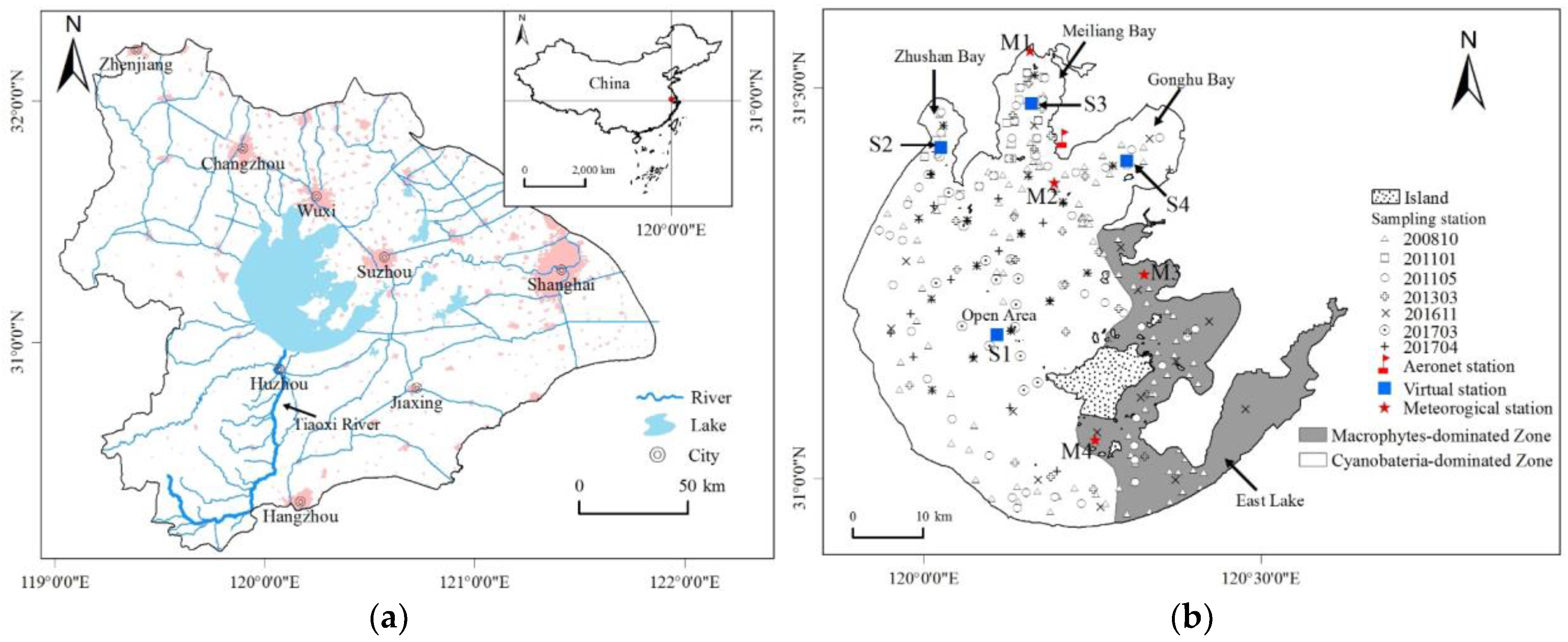
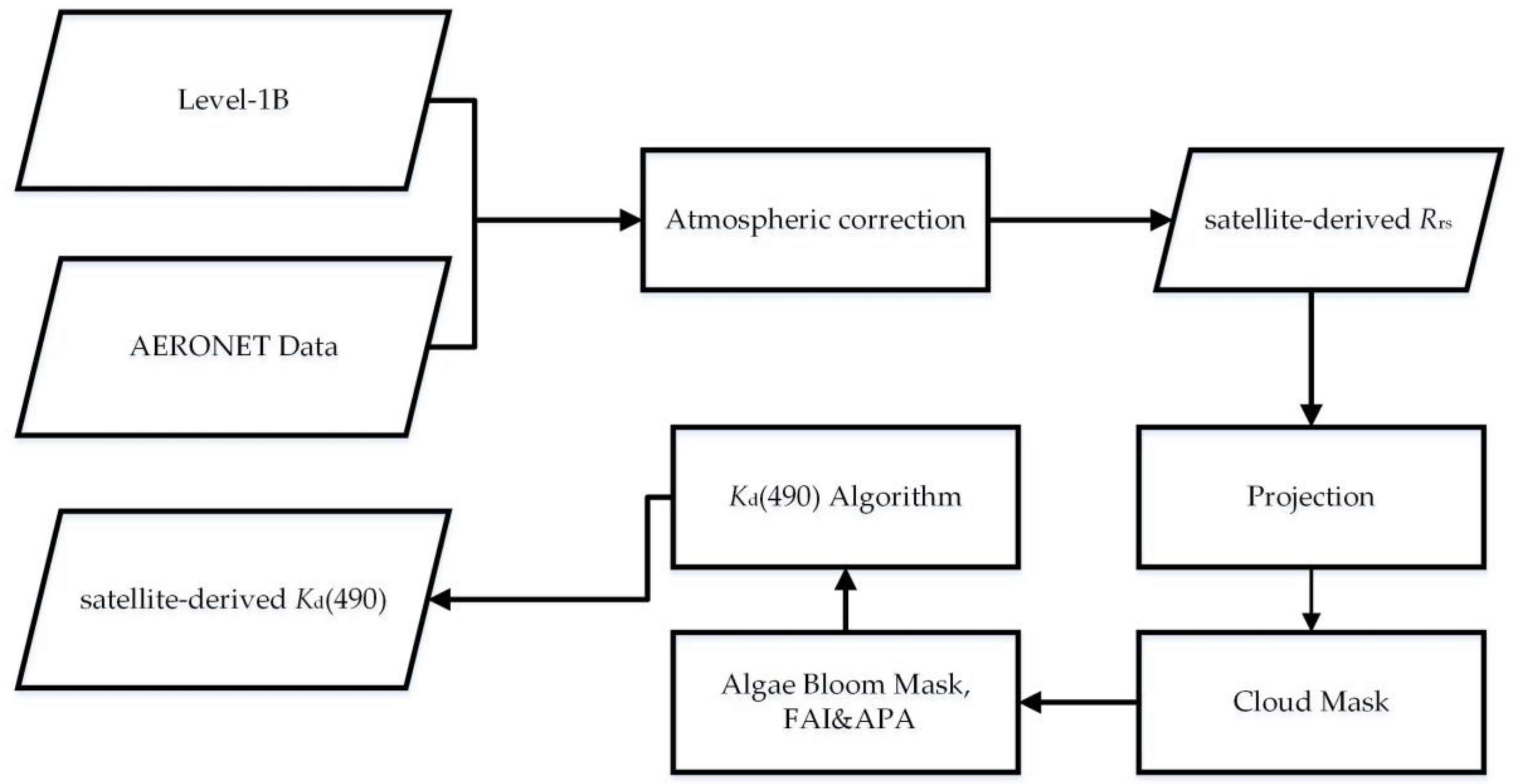




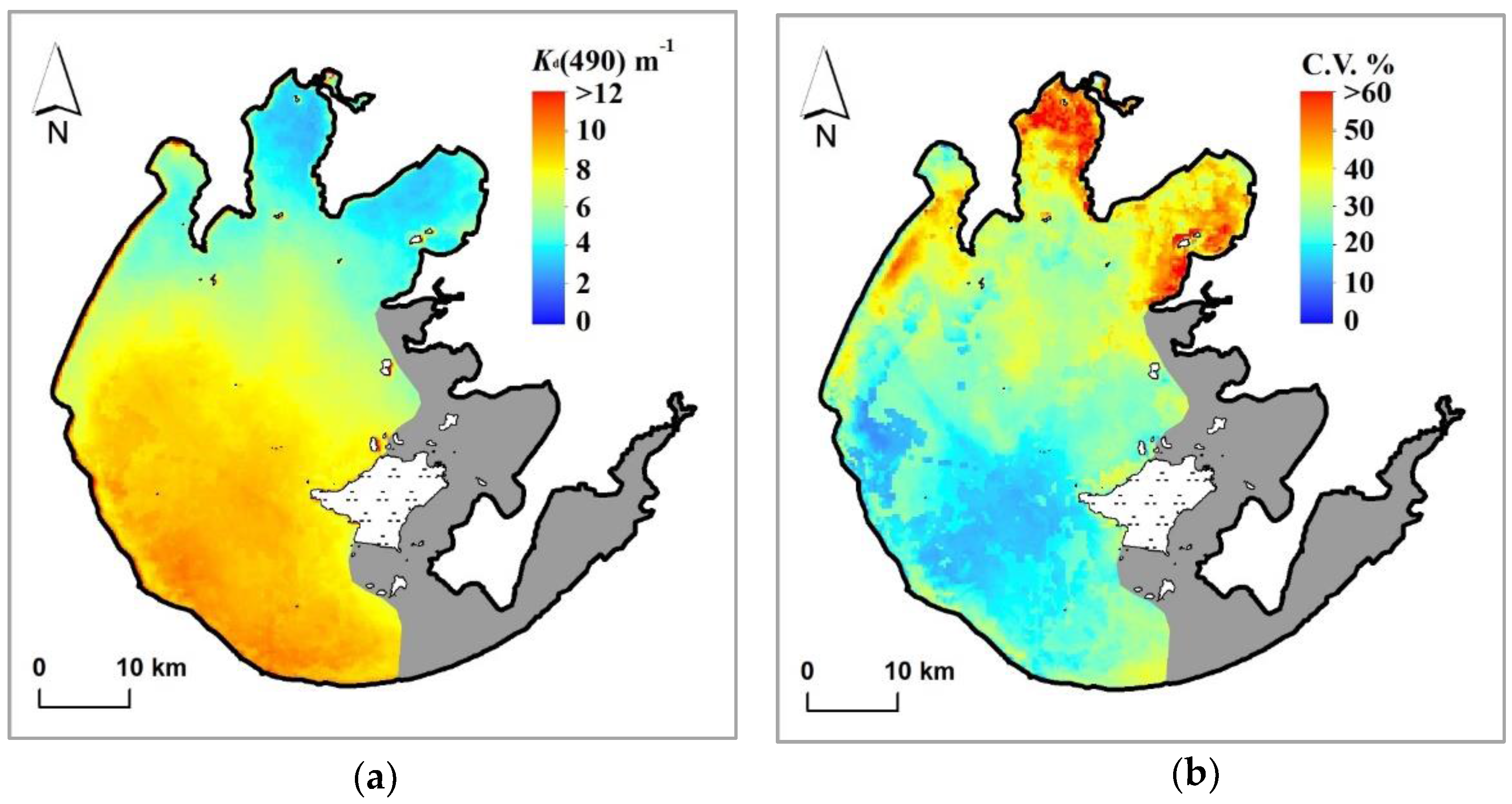
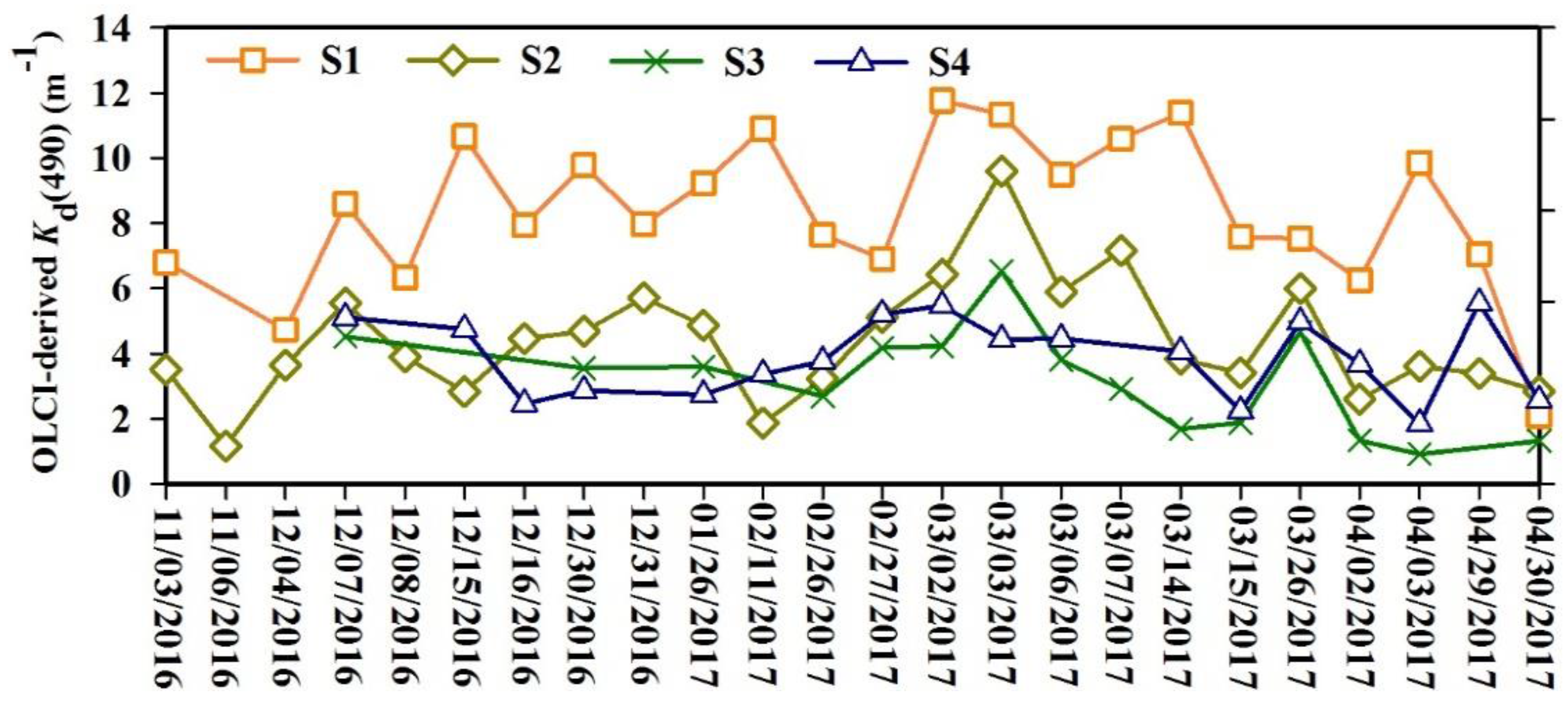
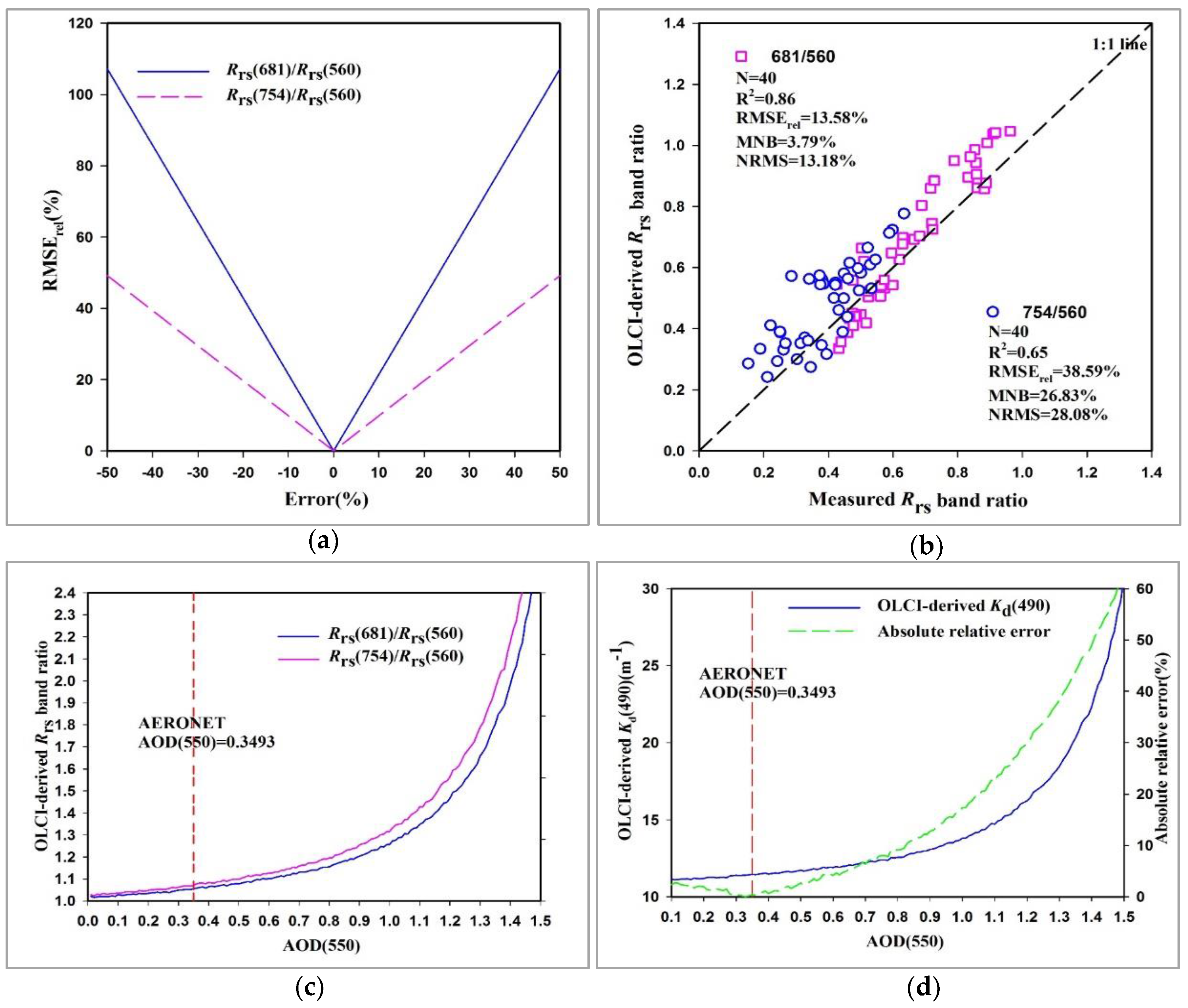
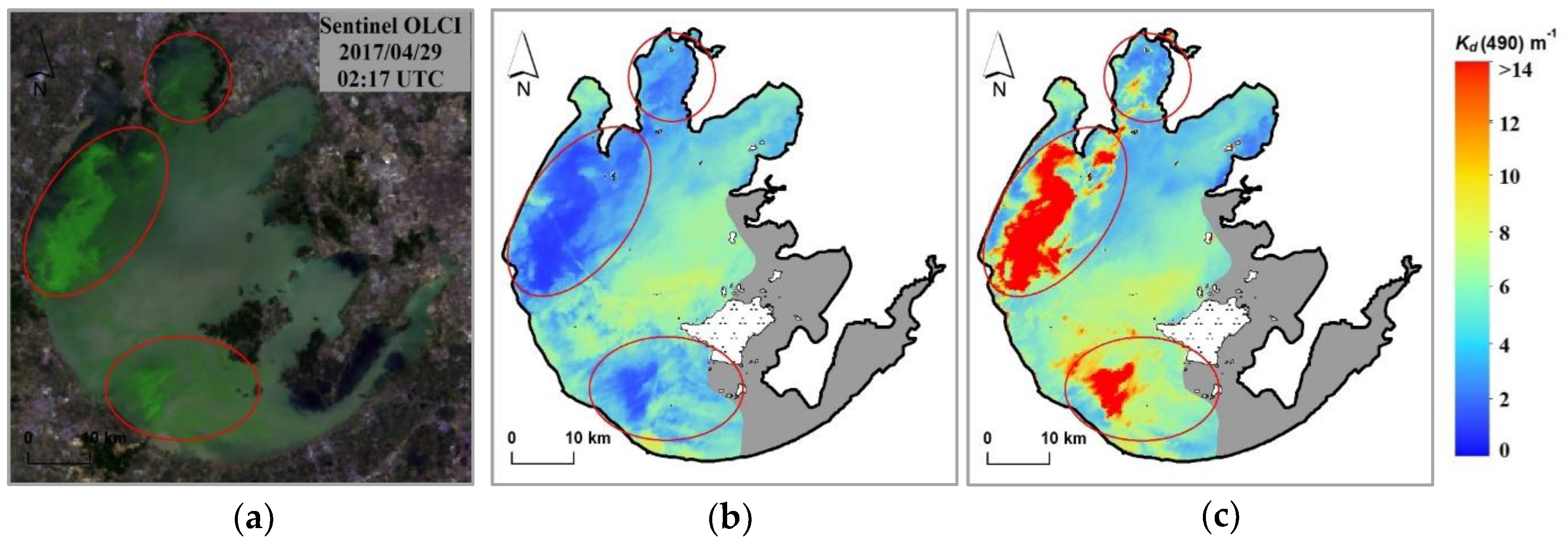
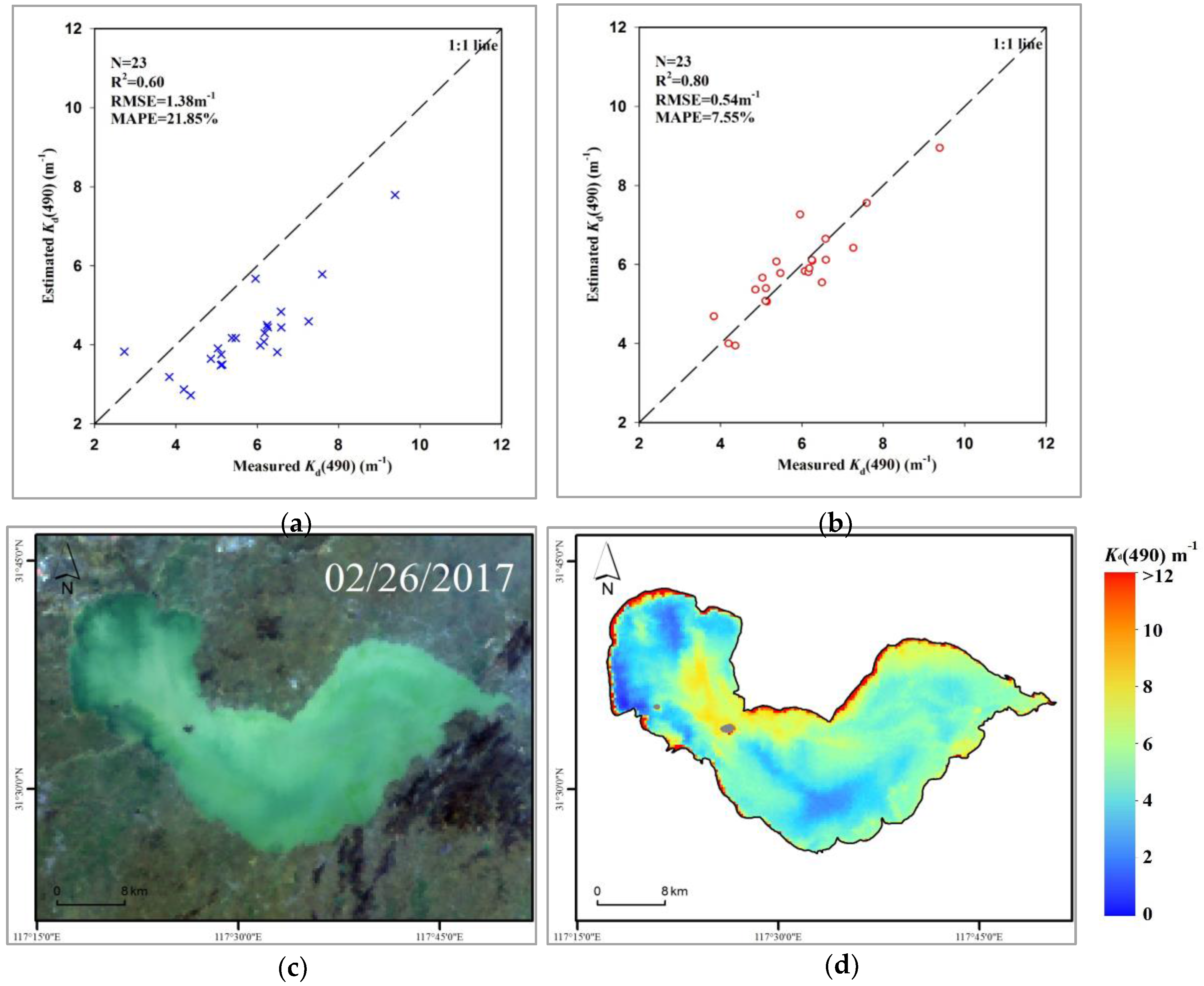
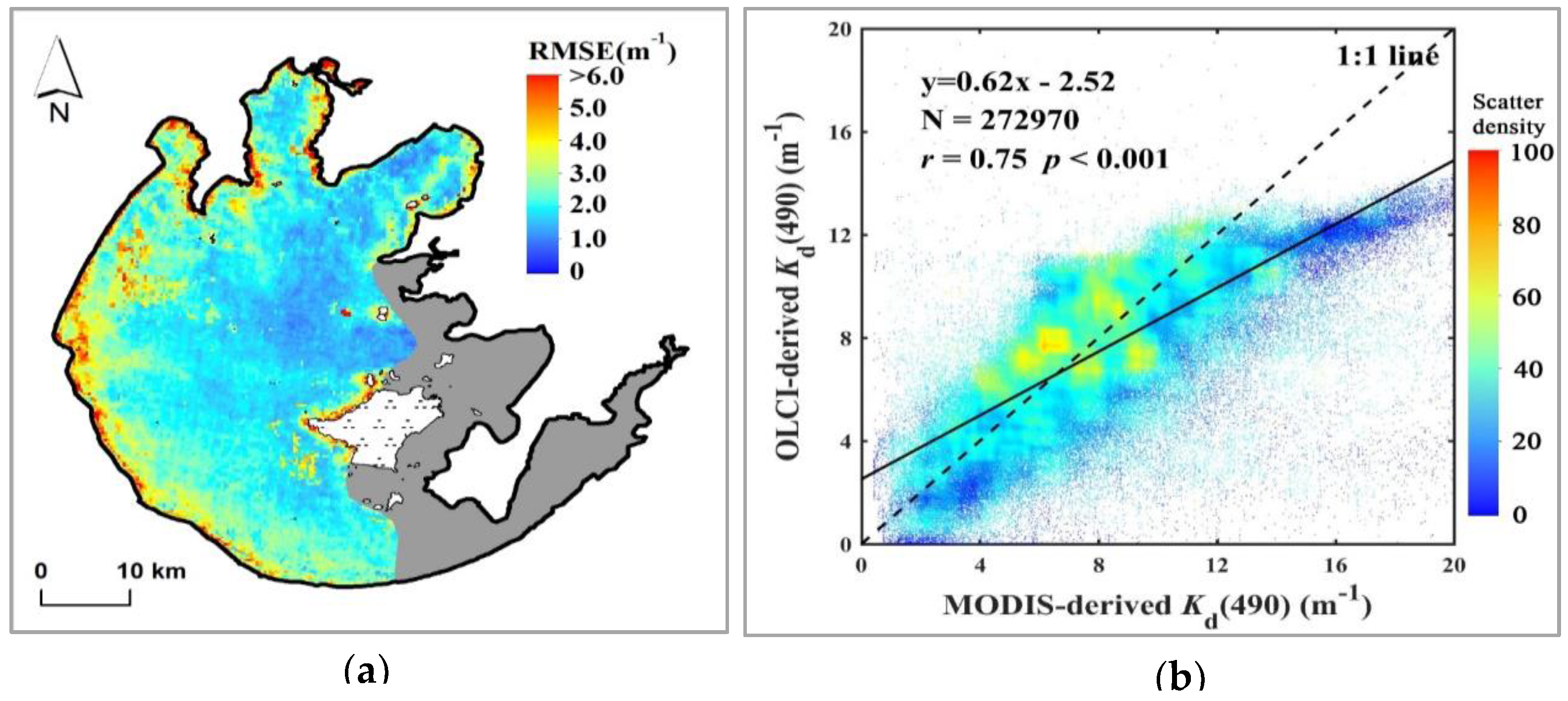
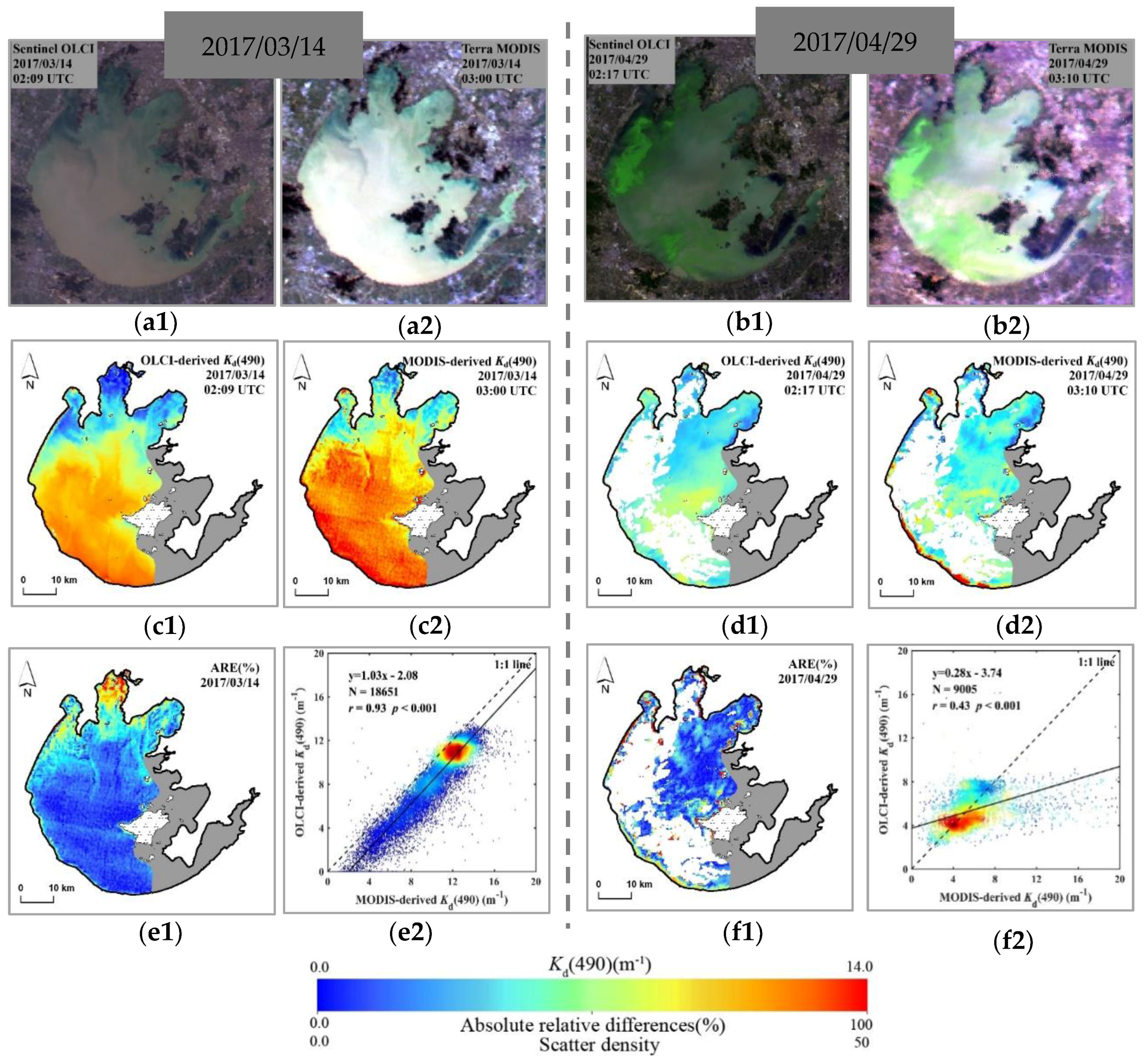
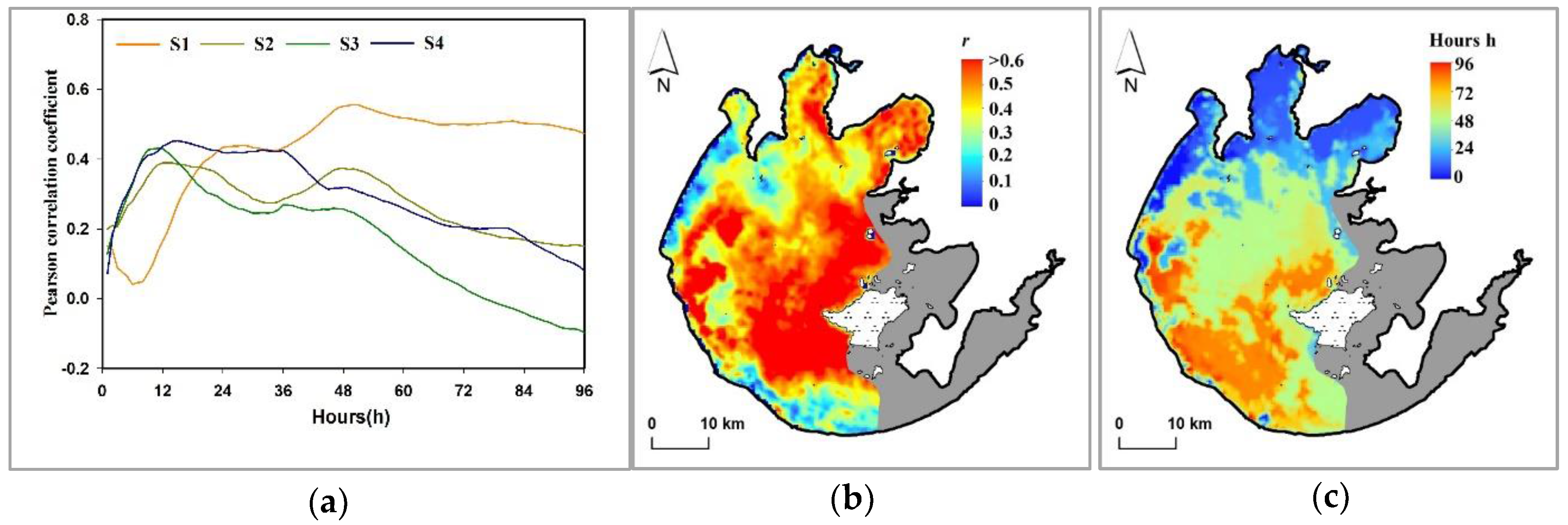
| Parameters | Statistics | October-2008 | Jane-2011 | May-2011 | March-2013 | November-2016 | March-2017 | April-2017 |
|---|---|---|---|---|---|---|---|---|
| Chla (μg/L) | Range | 0.46–148.30 | 10.80–31.00 | 1.75–46.70 | 6.57–51.26 | 5.60–105.26 | 17.79–88 | 9.85–157.05 |
| Mean ± S.D. | 21.89 ± 20.50 | 17.68 ± 7.27 | 14.35 ± 10.80 | 20.77 ± 12.90 | 24.94 ± 22.99 | 32.79 ± 21.17 | 46.32 ± 31.84 | |
| SPM (mg/L) | Range | 1.57–94.80 | 9.40–44.45 | 10.92–150.60 | 5.00–127.00 | 22.00–125.00 | 24.00–180.00 | 21.33–130.67 |
| Mean ± S.D. | 33.75 ± 18.34 | 22.53 ± 8.59 | 44.67 ± 28.58 | 61.39 ± 36.02 | 51.21 ± 26.41 | 113.33 ± 48.87 | 49.52 ± 24.07 | |
| SPOM (mg/L) | Range | 1.00–29.27 | 4.90–26.25 | 3.52–41.13 | 1.00–41.00 | 6.00–81.00 | 9.33–22.67 | 9.33–64.00 |
| Mean ± S.D. | 10.67 ± 4.60 | 7.62 ± 4.94 | 7.95 ± 5.74 | 13.98 ± 10.67 | 15.45 ± 13.22 | 18.31 ± 3.79 | 23.68 ± 12.85 | |
| SPIM (mg/L) | Range | 0.57–71.10 | 4.20–24.80 | 6.92–132.45 | 0.50–116.00 | 12.00–85.00 | 13.33–157.33 | 6.67–69.33 |
| Mean ± S.D. | 23.07 ± 14.87 | 14.91 ± 6.37 | 36.72 ± 25.60 | 47.41 ± 31.81 | 35.76 ± 20.40 | 95.02 ± 46.14 | 25.83 ± 15.63 | |
| ad(440) (m−1) | Range | 0.16–6.06 | 0.36–1.71 | 0.11–2.68 | 0.48–6.55 | 0.65–4.58 | 0.72–8.00 | 0.17–3.54 |
| Mean ± S.D. | 2.01 ± 1.14 | 1.00 ± 0.43 | 0.86 ± 0.58 | 2.30 ± 1.34 | 2.10 ± 0.87 | 4.14 ± 2.07 | 1.37 ± 0.86 | |
| ag(440) (m−1) | Range | 0.40–1.67 | 0.57–2.42 | 0.40–4.16 | 0.34–0.97 | 0.30–5.15 | 0.49–1.60 | 0.56–2.29 |
| Mean ± S.D. | 0.87 ± 0.28 | 1.35 ± 0.62 | 1.37 ± 0.98 | 0.62 ± 0.14 | 1.55 ± 0.83 | 0.85 ± 0.29 | 1.19 ± 0.60 | |
| aph(665) (m−1) | Range | 0.01–0.85 | 0.26–0.88 | 0.05–0.94 | 0.20–1.12 | 0.05–0.92 | 0.20–0.98 | 0.16–2.42 |
| Mean ± S.D. | 0.18 ± 0.15 | 0.43 ± 0.18 | 0.31 ± 0.20 | 0.41 ± 0.22 | 0.29 ± 0.18 | 0.44 ± 0.21 | 0.67 ± 0.47 | |
| Kd(490) (m−1) | Range | 0.73–7.59 | 1.58–4.85 | 2.58–7.14 | 2.24–8.04 | 2.71–10.68 | / | 1.84–8.40 |
| Mean ± S.D. | 4.50 ± 1.88 | 3.23 ± 1.09 | 4.52 ± 1.30 | 4.51 ± 1.52 | 5.71 ± 2.56 | / | 4.01 ± 1.92 |
| Type | Equation | R2 | RMSE/m−1 | RMSErel/m−1 | MNB/% | NRMS/% | Reference |
|---|---|---|---|---|---|---|---|
| Empirical algorithm | 0.34 | 1.88 | 47.39 | 15.89 | 45.21 | [21] | |
| 0.02 | 2.30 | 64.00 | 25.95 | 59.25 | [22] | ||
| 0.71 | 1.26 | 34.68 | 7.28 | 34.34 | [20] | ||
| Semi-analytical algorithm | 0.43 | 2.86 | 47.55 | −45.25 | 14.79 | [4] | |
| This study | 0.81 | 0.99 | 25.36 | 2.81 | 25.73 | - |
© 2017 by the authors. Licensee MDPI, Basel, Switzerland. This article is an open access article distributed under the terms and conditions of the Creative Commons Attribution (CC BY) license (http://creativecommons.org/licenses/by/4.0/).
Share and Cite
Shen, M.; Duan, H.; Cao, Z.; Xue, K.; Loiselle, S.; Yesou, H. Determination of the Downwelling Diffuse Attenuation Coefficient of Lake Water with the Sentinel-3A OLCI. Remote Sens. 2017, 9, 1246. https://doi.org/10.3390/rs9121246
Shen M, Duan H, Cao Z, Xue K, Loiselle S, Yesou H. Determination of the Downwelling Diffuse Attenuation Coefficient of Lake Water with the Sentinel-3A OLCI. Remote Sensing. 2017; 9(12):1246. https://doi.org/10.3390/rs9121246
Chicago/Turabian StyleShen, Ming, Hongtao Duan, Zhigang Cao, Kun Xue, Steven Loiselle, and Herve Yesou. 2017. "Determination of the Downwelling Diffuse Attenuation Coefficient of Lake Water with the Sentinel-3A OLCI" Remote Sensing 9, no. 12: 1246. https://doi.org/10.3390/rs9121246




